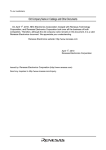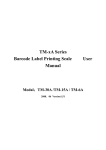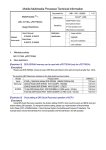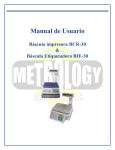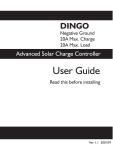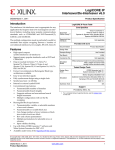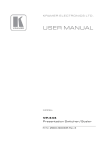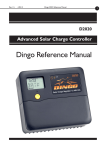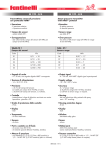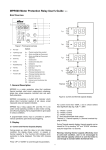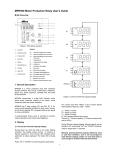Download Multimedia Processor for Mobile Applications (EMMA
Transcript
To our customers, Old Company Name in Catalogs and Other Documents On April 1st, 2010, NEC Electronics Corporation merged with Renesas Technology Corporation, and Renesas Electronics Corporation took over all the business of both companies. Therefore, although the old company name remains in this document, it is a valid Renesas Electronics document. We appreciate your understanding. Renesas Electronics website: http://www.renesas.com April 1st, 2010 Renesas Electronics Corporation Issued by: Renesas Electronics Corporation (http://www.renesas.com) Send any inquiries to http://www.renesas.com/inquiry. Notice 1. 2. 3. 4. 5. 6. 7. All information included in this document is current as of the date this document is issued. Such information, however, is subject to change without any prior notice. Before purchasing or using any Renesas Electronics products listed herein, please confirm the latest product information with a Renesas Electronics sales office. Also, please pay regular and careful attention to additional and different information to be disclosed by Renesas Electronics such as that disclosed through our website. Renesas Electronics does not assume any liability for infringement of patents, copyrights, or other intellectual property rights of third parties by or arising from the use of Renesas Electronics products or technical information described in this document. No license, express, implied or otherwise, is granted hereby under any patents, copyrights or other intellectual property rights of Renesas Electronics or others. You should not alter, modify, copy, or otherwise misappropriate any Renesas Electronics product, whether in whole or in part. Descriptions of circuits, software and other related information in this document are provided only to illustrate the operation of semiconductor products and application examples. You are fully responsible for the incorporation of these circuits, software, and information in the design of your equipment. Renesas Electronics assumes no responsibility for any losses incurred by you or third parties arising from the use of these circuits, software, or information. When exporting the products or technology described in this document, you should comply with the applicable export control laws and regulations and follow the procedures required by such laws and regulations. You should not use Renesas Electronics products or the technology described in this document for any purpose relating to military applications or use by the military, including but not limited to the development of weapons of mass destruction. Renesas Electronics products and technology may not be used for or incorporated into any products or systems whose manufacture, use, or sale is prohibited under any applicable domestic or foreign laws or regulations. Renesas Electronics has used reasonable care in preparing the information included in this document, but Renesas Electronics does not warrant that such information is error free. Renesas Electronics assumes no liability whatsoever for any damages incurred by you resulting from errors in or omissions from the information included herein. Renesas Electronics products are classified according to the following three quality grades: “Standard”, “High Quality”, and “Specific”. The recommended applications for each Renesas Electronics product depends on the product’s quality grade, as indicated below. You must check the quality grade of each Renesas Electronics product before using it in a particular application. You may not use any Renesas Electronics product for any application categorized as “Specific” without the prior written consent of Renesas Electronics. Further, you may not use any Renesas Electronics product for any application for which it is not intended without the prior written consent of Renesas Electronics. Renesas Electronics shall not be in any way liable for any damages or losses incurred by you or third parties arising from the use of any Renesas Electronics product for an application categorized as “Specific” or for which the product is not intended where you have failed to obtain the prior written consent of Renesas Electronics. The quality grade of each Renesas Electronics product is “Standard” unless otherwise expressly specified in a Renesas Electronics data sheets or data books, etc. “Standard”: 8. 9. 10. 11. 12. Computers; office equipment; communications equipment; test and measurement equipment; audio and visual equipment; home electronic appliances; machine tools; personal electronic equipment; and industrial robots. “High Quality”: Transportation equipment (automobiles, trains, ships, etc.); traffic control systems; anti-disaster systems; anticrime systems; safety equipment; and medical equipment not specifically designed for life support. “Specific”: Aircraft; aerospace equipment; submersible repeaters; nuclear reactor control systems; medical equipment or systems for life support (e.g. artificial life support devices or systems), surgical implantations, or healthcare intervention (e.g. excision, etc.), and any other applications or purposes that pose a direct threat to human life. You should use the Renesas Electronics products described in this document within the range specified by Renesas Electronics, especially with respect to the maximum rating, operating supply voltage range, movement power voltage range, heat radiation characteristics, installation and other product characteristics. Renesas Electronics shall have no liability for malfunctions or damages arising out of the use of Renesas Electronics products beyond such specified ranges. Although Renesas Electronics endeavors to improve the quality and reliability of its products, semiconductor products have specific characteristics such as the occurrence of failure at a certain rate and malfunctions under certain use conditions. Further, Renesas Electronics products are not subject to radiation resistance design. Please be sure to implement safety measures to guard them against the possibility of physical injury, and injury or damage caused by fire in the event of the failure of a Renesas Electronics product, such as safety design for hardware and software including but not limited to redundancy, fire control and malfunction prevention, appropriate treatment for aging degradation or any other appropriate measures. Because the evaluation of microcomputer software alone is very difficult, please evaluate the safety of the final products or system manufactured by you. Please contact a Renesas Electronics sales office for details as to environmental matters such as the environmental compatibility of each Renesas Electronics product. Please use Renesas Electronics products in compliance with all applicable laws and regulations that regulate the inclusion or use of controlled substances, including without limitation, the EU RoHS Directive. Renesas Electronics assumes no liability for damages or losses occurring as a result of your noncompliance with applicable laws and regulations. This document may not be reproduced or duplicated, in any form, in whole or in part, without prior written consent of Renesas Electronics. Please contact a Renesas Electronics sales office if you have any questions regarding the information contained in this document or Renesas Electronics products, or if you have any other inquiries. (Note 1) “Renesas Electronics” as used in this document means Renesas Electronics Corporation and also includes its majorityowned subsidiaries. (Note 2) “Renesas Electronics product(s)” means any product developed or manufactured by or for Renesas Electronics. User’s Manual Multimedia Processor for Mobile Applications Timer EMMA MobileTM1 Document No. S19266EJ3V0UM00 (3rd edition) Date Published September 2009 2009 Printed in Japan [MEMO] 2 User’s Manual S19266EJ3V0UM NOTES FOR CMOS DEVICES 1 VOLTAGE APPLICATION WAVEFORM AT INPUT PIN Waveform distortion due to input noise or a reflected wave may cause malfunction. If the input of the CMOS device stays in the area between VIL (MAX) and VIH (MIN) due to noise, etc., the device may malfunction. Take care to prevent chattering noise from entering the device when the input level is fixed, and also in the transition period when the input level passes through the area between VIL (MAX) and VIH (MIN). 2 HANDLING OF UNUSED INPUT PINS Unconnected CMOS device inputs can be cause of malfunction. If an input pin is unconnected, it is possible that an internal input level may be generated due to noise, etc., causing malfunction. CMOS devices behave differently than Bipolar or NMOS devices. Input levels of CMOS devices must be fixed high or low by using pull-up or pull-down circuitry. Each unused pin should be connected to VDD or GND via a resistor if there is a possibility that it will be an output pin. All handling related to unused pins must be judged separately for each device and according to related specifications governing the device. 3 PRECAUTION AGAINST ESD A strong electric field, when exposed to a MOS device, can cause destruction of the gate oxide and ultimately degrade the device operation. Steps must be taken to stop generation of static electricity as much as possible, and quickly dissipate it when it has occurred. Environmental control must be adequate. When it is dry, a humidifier should be used. It is recommended to avoid using insulators that easily build up static electricity. Semiconductor devices must be stored and transported in an anti-static container, static shielding bag or conductive material. All test and measurement tools including work benches and floors should be grounded. The operator should be grounded using a wrist strap. Semiconductor devices must not be touched with bare hands. Similar precautions need to be taken for PW boards with mounted semiconductor devices. 4 STATUS BEFORE INITIALIZATION Power-on does not necessarily define the initial status of a MOS device. Immediately after the power source is turned ON, devices with reset functions have not yet been initialized. Hence, power-on does not guarantee output pin levels, I/O settings or contents of registers. A device is not initialized until the reset signal is received. A reset operation must be executed immediately after power-on for devices with reset functions. 5 POWER ON/OFF SEQUENCE In the case of a device that uses different power supplies for the internal operation and external interface, as a rule, switch on the external power supply after switching on the internal power supply. When switching the power supply off, as a rule, switch off the external power supply and then the internal power supply. Use of the reverse power on/off sequences may result in the application of an overvoltage to the internal elements of the device, causing malfunction and degradation of internal elements due to the passage of an abnormal current. The correct power on/off sequence must be judged separately for each device and according to related specifications governing the device. 6 INPUT OF SIGNAL DURING POWER OFF STATE Do not input signals or an I/O pull-up power supply while the device is not powered. The current injection that results from input of such a signal or I/O pull-up power supply may cause malfunction and the abnormal current that passes in the device at this time may cause degradation of internal elements. Input of signals during the power off state must be judged separately for each device and according to related specifications governing the device. User’s Manual S19266EJ3V0UM 3 The names of other companies and products are the registered trademarks or trademarks of the respective company. • The information in this document is current as of September, 2009. The information is subject to change without notice. For actual design-in, refer to the latest publications of NEC Electronics data sheets, etc., for the most up-to-date specifications of NEC Electronics products. Not all products and/or types are available in every country. Please check with an NEC Electronics sales representative for availability and additional information. • No part of this document may be copied or reproduced in any form or by any means without the prior written consent of NEC Electronics. NEC Electronics assumes no responsibility for any errors that may appear in this document. • NEC Electronics does not assume any liability for infringement of patents, copyrights or other intellectual property rights of third parties by or arising from the use of NEC Electronics products listed in this document or any other liability arising from the use of such products. No license, express, implied or otherwise, is granted under any patents, copyrights or other intellectual property rights of NEC Electronics or others. • Descriptions of circuits, software and other related information in this document are provided for illustrative purposes in semiconductor product operation and application examples. The incorporation of these circuits, software and information in the design of a customer's equipment shall be done under the full responsibility of the customer. NEC Electronics assumes no responsibility for any losses incurred by customers or third parties arising from the use of these circuits, software and information. • While NEC Electronics endeavors to enhance the quality and safety of NEC Electronics products, customers agree and acknowledge that the possibility of defects thereof cannot be eliminated entirely. In addition, NEC Electronics products are not taken measures to prevent radioactive rays in the product design. When customers use NEC Electronics products with their products, customers shall, on their own responsibility, incorporate sufficient safety measures such as redundancy, fire-containment and anti-failure features to their products in order to avoid risks of the damages to property (including public or social property) or injury (including death) to persons, as the result of defects of NEC Electronics products. • NEC Electronics products are classified into the following three quality grades: "Standard", "Special" and "Specific". The "Specific" quality grade applies only to NEC Electronics products developed based on a customerdesignated "quality assurance program" for a specific application. The recommended applications of an NEC Electronics product depend on its quality grade, as indicated below. Customers must check the quality grade of each NEC Electronics product before using it in a particular application. "Standard": Computers, office equipment, communications equipment, test and measurement equipment, audio and visual equipment, home electronic appliances, machine tools, personal electronic equipment and industrial robots. "Special": Transportation equipment (automobiles, trains, ships, etc.), traffic control systems, anti-disaster systems, anti-crime systems, safety equipment and medical equipment (not specifically designed for life support). "Specific": Aircraft, aerospace equipment, submersible repeaters, nuclear reactor control systems, life support systems and medical equipment for life support, etc. The quality grade of NEC Electronics products is "Standard" unless otherwise expressly specified in NEC Electronics data sheets or data books, etc. If customers wish to use NEC Electronics products in applications not intended by NEC Electronics, they must contact an NEC Electronics sales representative in advance to determine NEC Electronics' willingness to support a given application. (Note) (1) "NEC Electronics" as used in this statement means NEC Electronics Corporation and also includes its majority-owned subsidiaries. (2) "NEC Electronics products" means any product developed or manufactured by or for NEC Electronics (as defined above). M8E0904E 4 User’s Manual S19266EJ3V0UM PREFACE Readers This manual is intended for hardware/software application system designers who wish to understand and use the timer module (ATIM) functions of EMMA Mobile1 (EM1), a multimedia processor for mobile applications. Purpose This manual is intended to explain to users the hardware and software functions of the timer module (ATIM) of EM1, and be used as a reference material for developing hardware and software for systems that use EM1. Organization How to Read This Manual This manual consists of the following chapters. Chapter 1 Overview Chapter 2 Registers Chapter 3 Description of functions Chapter 4 Usage It is assumed that the readers of this manual have general knowledge of electricity, logic circuits, and microcontrollers. To understand the functions of the timer module (ATIM) of EM1 in detail Read this manual according to the CONTENTS. To understand the other functions of EM1 Refer to the user’s manual of the respective module. To understand the electrical specifications of EM1 Conventions Refer to the Data Sheet. Data significance: Higher digits on the left and lower digits on the right Note: Footnote for item marked with Note in the text Caution: Information requiring particular attention Remark: Supplementary information Numeric representation: Binary ... xxxx or xxxxB Decimal ... xxxx Hexadecimal ... xxxxH Data type: Word … 32 bits Halfword … 16 bits Byte User’s Manual S19266EJ3V0UM … 8 bits 5 Related Documents The related documents indicated in this publication may include preliminary versions. However, preliminary versions are not marked as such. Document Name Document No. MC-10118A Data sheet S19657E μPD77630A Data sheet S19686E User’s manual Audio/Voice and PWM Interfaces S19253E DDR SDRAM Interface S19254E DMA Controller S19255E 2 Caution I C Interface S19256E ITU-R BT.656 Interface S19257E LCD Controller S19258E MICROWIRE S19259E NAND Flash Interface S19260E SPI S19261E UART Interface S19262E Image Composer S19263E Image Processor Unit S19264E System Control/General-Purpose I/O Interface S19265E Timer This manual Terrestrial Digital TV Interface S19267E Camera Interface S19285E USB Interface S19359E SD Memory Card Interface S19361E PDMA S19373E One Chip (MC-10118A) S19598E One Chip (μPD77630A) S19687E The related documents listed above are subject to change without notice. Be sure to use the latest version of each document when designing. 6 User’s Manual S19266EJ3V0UM CONTENTS CHAPTER 1 OVERVIEW............................................................................................................................9 1.1 1.2 1.3 General.........................................................................................................................................9 Features .......................................................................................................................................9 Timer Module Block Diagram ..................................................................................................10 CHAPTER 2 REGISTERS ........................................................................................................................11 2.1 2.2 Offset Address ..........................................................................................................................11 Registers....................................................................................................................................11 2.2.1 Timer operation register ................................................................................................................ 12 2.2.2 Timer clear register .......................................................................................................................13 2.2.3 Timer value setting register........................................................................................................... 14 2.2.4 Real count read register................................................................................................................ 15 2.2.5 Timer value setting monitor register.............................................................................................. 15 CHAPTER 3 DESCRIPTION OF FUNCTIONS ......................................................................................16 3.1 3.2 Status After Reset.....................................................................................................................16 Calculation of Timer Count ......................................................................................................16 CHAPTER 4 USAGE ................................................................................................................................17 4.1 4.2 4.3 4.4 4.5 Starting the Timer .....................................................................................................................17 Pausing the Timer .....................................................................................................................19 Stopping the Timer ...................................................................................................................20 Clearing the Timer Count Value Timer ...................................................................................21 Rewriting the Timer Count Value ............................................................................................22 User’s Manual S19266EJ3V0UM 7 LIST OF FIGURES Figure No. Title Page Figure 1-1. ATIM_Txx Block Diagram ......................................................................................................................... 10 Figure 4-1. Starting the Timer ..................................................................................................................................... 17 Figure 4-2. Pausing the Timer..................................................................................................................................... 19 Figure 4-3. Stopping the Timer.................................................................................................................................... 20 Figure 4-4. Clearing the Timer Count Value Timer...................................................................................................... 21 Figure 4-5. Rewriting the Timer Count Value .............................................................................................................. 22 8 User’s Manual S19266EJ3V0UM CHAPTER 1 OVERVIEW 1.1 General The timer module (ATIM) is a programmable timer counter that enables 32-bit counting (1 to FFFF_FFFFH). 1.2 Features (1) When a timer counts out (counts up to the user-set count value), the timer count value returns to 0 (0000_0000H) and the timer starts counting again (free-run counting). (2) The TOUT signal is asserted each time a timer counts out and the TOUT signal is output for two TIN clock cycles. (3) Once the ATIM registers are set up and the timer starts counting, the ATIM continues counting as described in (1) as long as the TIN clock is supplied, even if the APB bus clock (PCLK) is stopped. (4) The timer count set value can be changed while the timer is counting. (5) ATIM has 14 functionally equivalent timer modules (TI0 to TI3, TW0 to TW3, and TG0 to TG5). User’s Manual S19266EJ3V0UM 9 CHAPTER 1 OVERVIEW 1.3 Timer Module Block Diagram Figure 1-1. ATIM_Txx Block Diagram TXX_RSTZ PCLK sync TXX_PCLK TIN sync TXX_TIN RSTn RSTn Timer value setting register TMSET [31:0] Internal system bus TMSET[31:0] TO_EN Comparator Register TM_EN, TSTART Real count register [31:0] TM_CLR 10 User’s Manual S19266EJ3V0UM TXX_TOUT CHAPTER 2 REGISTERS ATIM has 256-byte register spaces for each module (TI0 to TI3, TW0 to TW3, and TG0 to TG5), which have different offset addresses. 2.1 Offset Address PB1_PADDR[31:0] Module C000_0000H TI0 C000_0100H TI1 C000_0200H TI2 C000_0300H TI3 C000_1000H TW0 C000_1100H TW1 C000_1200H TW2 C000_1300H TW3 C000_2000H TG0 C000_2100H TG1 C000_2200H TG2 C000_2300H TG3 C000_2400H TG4 C000_2500H TG5 2.2 Registers Each ATIM register consists of 32 bits. Address Register Name Symbol R/W After Reset 0000H Timer operation register xxx_OP R/W 0000_0000H 0004H Timer clear register xxx_CLR W 0000_0000H 0008H Timer value setting register xxx_SET R/W 0000_0000H 000CH Real count read register xxx_RCR R 0000_0000H 0010H Reserved 0014H Timer value setting monitor register 0018H to Reserved xxx_SCLR R/W 0000_0000H 00FCH (xxx = TI0/TI1/TI2/TI3/TW0/TW1/TW2/TW3/TG0/TG1/TG2/TG3/TG4/TG5) Operation when a reserved area is accessed: Write: Ignored (invalid) Read: Zeros are returned. User’s Manual S19266EJ3V0UM 11 CHAPTER 2 REGISTERS 2.2.1 Timer operation register This register (xxx_OP: xxxx_0000H) control the timer operations. 31 30 29 28 27 26 25 24 19 18 17 16 11 10 9 8 3 2 1 0 TO_EN TSTART TM_EN Reserved 23 22 21 20 Reserved 15 14 13 12 Reserved 7 6 5 4 Reserved Name Reserved TO_EN R/W Bit After Reset Function 31:3 0 Reserved. R/W 2 0 Specifies whether to assert the TOUT signal. 0: Does not assert the TOUT signal even if timer counting times out. 1: Asserts the TOUT signal when timer counting times out. TSTART R/W 1 0 Starts timer counting (valid when TM_EN = 1) 0: Does not start timer counting. (The internal timer count register retains the current value.) 1: Starts timer counting. (The internal timer count register is incremented per TIN clock cycle). TM_EN R/W 0 0 Specifies whether to enable the timer operation. 0: Disables the timer operation. The internal timer count register value is reset to 0. 1: Enables the timer operation. Caution Make sure that the interrupt enable period is at least five internal clock cycles + four TIN clock cycles, because the register value is output in synchronization with PCLK and TOUT is output in synchronization with the TIN clock. 12 User’s Manual S19266EJ3V0UM CHAPTER 2 REGISTERS 2.2.2 Timer clear register This register (xxx_CLR: xxxx_0004H) clears the internal timer count registers. 31 30 29 28 27 26 25 24 19 18 17 16 11 10 9 8 3 2 1 0 TCR_CLR Reserved Reserved 23 22 21 20 Reserved 15 14 13 12 Reserved 7 6 5 4 Reserved Name R/W Bit After Reset Function Reserved 31:2 0 Reserved. TCR_CLR W 1 0 Clears the internal timer count registers. 0: No operation 1: Clears the internal timer count registers. This bit is automatically cleared to “0”. (Re-setting “0” is unnecessary). For details, see 4.4 Timer count value clear operation. Reserved 0 0 Reserved. User’s Manual S19266EJ3V0UM 13 CHAPTER 2 REGISTERS 2.2.3 Timer value setting register This register (xxx_SET: xxxx_0008H) specifies the value at which the timer counts out. 31 30 29 28 27 26 25 24 TMSET_31 TMSET_30 TMSET_29 TMSET_28 TMSET_27 TMSET_26 TMSET_25 TMSET_24 23 22 21 20 19 18 17 16 TMSET_23 TMSET_22 TMSET_21 TMSET_20 TMSET_19 TMSET_18 TMSET_17 TMSET_16 15 14 13 12 11 10 9 8 TMSET_15 TMSET_14 TMSET_13 TMSET_12 TMSET_11 TMSET_10 TMSET_9 TMSET_8 7 6 5 4 3 2 1 0 TMSET_7 TMSET_6 TMSET_5 TMSET_4 TMSET_3 TMSET_2 TMSET_1 TMSET_0 Name R/W Bit After Reset TMSET_[31:0] R/W 31:0 0 Function Specifies the value at which the timer counts out. Set a desired value minus 1. Specify a value greater than or equal to 2. When a timer counts out, the TOUT signal is asserted (when TO_EN = 1) and the real count register is reset to 0. For details, see 4.5 Rewriting the Timer Count Value. Caution Before setting values in this register, read the TM_SCLR bit of the timer value setting monitor register (xxx_SCLR: xxxx_xx14H), confirm that the LSB of the read value is “0”, and then wait for at least two or three TIN clock cycles. 14 User’s Manual S19266EJ3V0UM CHAPTER 2 REGISTERS 2.2.4 Real count read register This register (xxx_RCR: xxxx_000CH) is used to read the real count registers (current timer value). 31 30 29 28 27 26 25 24 RCR_31 RCR_30 RCR_29 RCR_28 RCR_27 RCR_26 RCR_25 RCR_24 23 22 21 20 19 18 17 16 RCR_23 RCR_22 RCR_21 RCR_20 RCR_19 RCR_18 RCR_17 RCR_16 15 14 13 12 11 10 9 8 RCR_15 RCR_14 RCR_13 RCR_12 RCR_11 RCR_10 RCR_9 RCR_8 7 6 5 4 3 2 1 0 RCR_7 RCR_6 RCR_5 RCR_4 RCR_3 RCR_2 RCR_1 RCR_0 Name R/W Bit After Reset R 31:0 0 RCR_[31:0] Function Used to read the real count register values. 2.2.5 Timer value setting monitor register This register (xxx_SCLR: xxxx_0014H) is used to monitor the timer value setting. 31 30 29 28 27 26 25 24 19 18 17 16 11 10 9 8 3 2 1 0 Reserved 23 22 21 20 Reserved 15 14 13 12 Reserved 7 6 5 4 Reserved Name Reserved TM_SCLR TM_SCLR R/W Bit After Reset Function 31:1 0 Reserved. R/W 0 0 Monitors the timer value setting. This bit holds 1H until a count value is set to the timer value setting register. After a value is set, this bit is automatically reset to 0H. Remarks 1. This bit is not automatically reset to 0 when the TM_EN bit of the timer operation register is set to 0. 2. If the timer value is set in the timer value setting register (TMSET bits) while the TM_SCLR bit is set to 1, the TM_SCLR bit is fixed to “1”. In this case, reset this bit. User’s Manual S19266EJ3V0UM 15 CHAPTER 3 DESCRIPTION OF FUNCTIONS 3.1 Status After Reset ATIM is set as follows after reset. TOUT signal polarity: 0 Timer count: Stop Timer setting register: 0x0000_0000 Internal timer count register: 0x0000_0000 3.2 Calculation of Timer Count A wide range of counting is possible by using a combination of input frequency and timer count settings. The following table shows setting examples. The term [seconds] in this table refers to the interval at which the TOUT signal is asserted. TIN (Input Frequency) 32.768 kHz 15.616 MHz Timer Count Setting Value 0000_0000H 6 30.52 10 [seconds] 9 64.04 10 [seconds] 0000_FFFFH 2 [seconds] 3 4.20 10 [seconds] FFFF_FFFFH 131072 [seconds] 275.04 [seconds] Expression: (1/TIN) (Count setting value + 1) Example: 16 1/32.768 kHz (0000_FFFFH + 1) = 30.52 10E6 65536 = 2 [seconds] User’s Manual S19266EJ3V0UM CHAPTER 4 USAGE 4.1 Starting the Timer (1) Set up the timer value setting register: TMSET = count value (2) Enable the timer: TM_EN = 1 (bit 0 of xxx_OP register) (3) Enable TOUT signal assertion: TO_EN = 1 (bit 2 of xxx_OP register) (4) Start timer counting: TSTART = 1 (bit 1 of xxx_OP register) Figure 4-1. Starting the Timer (Example: When the timer value is set to 7) <1> Steps (2) to (4) can be performed with a single write. <2> The TOUT signal is asserted under the following conditions. (1) The timer value setting register (TMSET) is set to a value other than “0” (2) Asserting the TOUT signal is enabled (TO_EN = 1) (3) The timer is counting (TM_EN = 1, TSTART = 1). With these settings, the TOUT signal is asserted every 8 TIN clock cycles. To set the TOUT signal assertion cycle to 8, set the timer value setting register to 7 (8 − 1). <3> The internal timer count register operates even if the system clock (PCLK) is stopped after the timer starts, as long as the TIN clock is supplied. The TOUT signal is asserted according to the timer value setting (every 8 clock cycles in this example). User’s Manual S19266EJ3V0UM 17 CHAPTER 4 USAGE Notes 1. Registers are set in synchronization with PCLK, and real counting occurs in synchronization with TIN. PCLK and TIN are asynchronous. 2. The TSTART, TO_EN, TM_EN, and TMSET bits are set in synchronization with PCLK. However, because real counting occurs in synchronization with TIN, the setting of the TSTART, TO_EN, TM_EN, and TMSET bits will not be applied for 2 or 3 TIN cycles. This is the case regardless of whether the timer is set again while it is counting or when it is stopped. 18 User’s Manual S19266EJ3V0UM CHAPTER 4 USAGE 4.2 Pausing the Timer (1) Stop timer counting (with count values retained): TM_EN = 1, TSTART = 0 (pause for a certain period) (2) Restart timer counting: TM_EN = 1, TSTART = 1 Figure 4-2. Pausing the Timer Notes 1. Registers are set in synchronization with APBCLK, and real counting occurs in synchronization with TIN. APBCLK and TIN are asynchronous. 2. The TSTART and TM_EN bits are set in synchronization with PCLK. However, because real counting occurs in synchronization with TIN, the setting of the TSTART and TM_EN bits will not be applied for 2 or 3 TIN cycles. This is the case regardless of whether the timer is set again while it is counting or when it is stopped. User’s Manual S19266EJ3V0UM 19 CHAPTER 4 USAGE 4.3 Stopping the Timer (1) Stop timer counting (internal count value returns to 0): TM_EN = 0, TSTART = * Figure 4-3. Stopping the Timer Notes 1. Registers are set in synchronization with PCLK, and real counting occurs in synchronization with TIN. PCLK and TIN are asynchronous. 2. The TSTART and TM_EN bits are set in synchronization with PCLK. However, because real counting occurs in synchronization with TIN, the setting of the TSTART and TM_EN bits will not be applied for 2 or 3 TIN cycles. This is the case regardless of whether the timer is set again while it is counting or when it is stopped. 20 User’s Manual S19266EJ3V0UM CHAPTER 4 USAGE 4.4 Clearing the Timer Count Value Timer The values of the internal timer count register can be cleared to 0 with a single write operation during counting. This operation can be used during clearing of the watchdog timer. (The TOUT signal is not asserted if writing is performed at least once before the timer counts out.) (It's used as Watchdog timer: Multimedia Processor for Mobile Applications System Control/GeneralPurpose I/O Interface User’s Manual chapter 3.2.8). (1) Clears the timer count: TCR_CLR = 1 (bit 1 of xxx_CLR register) Figure 4-4. Clearing the Timer Count Value Timer <1> This bit is automatically cleared to “0” after the timer count value is cleared (TCR_CLR = 1). Notes 1. Registers are set in synchronization with PCLK, and real counting occurs in synchronization with TIN. PCLK and TIN are asynchronous. 2. After the timer count value is cleared, the timer count is actually cleared one PCLK cycle + two or three TIN cycles later because the value is specified to be cleared in synchronization with PCLK, but is actually cleared in synchronization with TIN. 3. When the timer count value is cleared, the signal is output from the register for one PCLK cycle, and clearing takes effect in synchronization with TIN (this takes three cycles). Next, a clear signal in synchronization with TIN is output for one cycle and is synchronized with PCLK again (this takes four cycles). The timer clear register is then cleared to 0, and the clear operation is complete. Therefore, a timer count that is cleared within five PCLK cycles + four TIN cycles is ignored. For the watchdog timer, set the timer value setting register (TMSET bits) to a value of at least (5 PCLK cycles) + (4 TIN cycles). User’s Manual S19266EJ3V0UM 21 CHAPTER 4 USAGE 4.5 Rewriting the Timer Count Value The maximum value of real counting can be changed by changing the values of the relevant timer value setting register (TMSET) while the timer is counting. (1) Set up the timer value setting register: TMSET = count value (2) Enable the timer: TM_EN = 1 (bit 0 of xxx_OP register) (3) Enable TOUT signal assertion: TO_EN = 1 (bit 2 of xxx_OP register) (4) Start timer counting: TSTART = 1 (bit 1 of xxx_OP register) (5) Set up the timer value setting register: TMSET = count value (count value different from that of (1)) Figure 4-5. Rewriting the Timer Count Value Notes 1. Registers are set in synchronization with PCLK, and real counting occurs in synchronization with TIN. PCLK and TIN are asynchronous. 2. The TSTART, TO_EN, TM_EN, and TMSET bits are set in synchronization with PCLK. However, because real counting occurs in synchronization with TIN, the setting of the TSTART, TO_EN, TM_EN, and TMSET bits will not be applied for 2 or 3 TIN cycles. This is the case regardless of whether the timer is set again while it is counting or when it is stopped. 3. If a value smaller than the real count value is set in the timer value setting register during counting, the timer counts up to FFFF_FFFFH, and then counts up to the preset count value. If this operation causes any problems, read the real count read register and set a value larger than the read value in the timer value setting register. 22 User’s Manual S19266EJ3V0UM Revision History Date Revision Comments February 10, 2009 1.0 − April 27, 2009 2.0 Incremental update from comments to the 1.0.. September 30, 2009 3.0 Incremental update from comments to the 2.0.. User’s Manual S19266EJ3V0UM 23 For further information, please contact: NEC Electronics Corporation 1753, Shimonumabe, Nakahara-ku, Kawasaki, Kanagawa 211-8668, Japan Tel: 044-435-5111 http://www.necel.com/ [America] [Europe] [Asia & Oceania] NEC Electronics America, Inc. 2880 Scott Blvd. Santa Clara, CA 95050-2554, U.S.A. Tel: 408-588-6000 800-366-9782 http://www.am.necel.com/ NEC Electronics (Europe) GmbH Arcadiastrasse 10 40472 Düsseldorf, Germany Tel: 0211-65030 http://www.eu.necel.com/ NEC Electronics (China) Co., Ltd 7th Floor, Quantum Plaza, No. 27 ZhiChunLu Haidian District, Beijing 100083, P.R.China Tel: 010-8235-1155 http://www.cn.necel.com/ Hanover Office Podbielskistrasse 166 B 30177 Hannover Tel: 0 511 33 40 2-0 Munich Office Werner-Eckert-Strasse 9 81829 München Tel: 0 89 92 10 03-0 Stuttgart Office Industriestrasse 3 70565 Stuttgart Tel: 0 711 99 01 0-0 United Kingdom Branch Cygnus House, Sunrise Parkway Linford Wood, Milton Keynes MK14 6NP, U.K. Tel: 01908-691-133 Succursale Française 9, rue Paul Dautier, B.P. 52 78142 Velizy-Villacoublay Cédex France Tel: 01-3067-5800 Sucursal en España Juan Esplandiu, 15 28007 Madrid, Spain Tel: 091-504-2787 Tyskland Filial Täby Centrum Entrance S (7th floor) 18322 Täby, Sweden Tel: 08 638 72 00 Filiale Italiana Via Fabio Filzi, 25/A 20124 Milano, Italy Tel: 02-667541 Shanghai Branch Room 2509-2510, Bank of China Tower, 200 Yincheng Road Central, Pudong New Area, Shanghai, P.R.China P.C:200120 Tel:021-5888-5400 http://www.cn.necel.com/ Shenzhen Branch Unit 01, 39/F, Excellence Times Square Building, No. 4068 Yi Tian Road, Futian District, Shenzhen, P.R.China P.C:518048 Tel:0755-8282-9800 http://www.cn.necel.com/ NEC Electronics Hong Kong Ltd. Unit 1601-1613, 16/F., Tower 2, Grand Century Place, 193 Prince Edward Road West, Mongkok, Kowloon, Hong Kong Tel: 2886-9318 http://www.hk.necel.com/ NEC Electronics Taiwan Ltd. 7F, No. 363 Fu Shing North Road Taipei, Taiwan, R. O. C. Tel: 02-8175-9600 http://www.tw.necel.com/ NEC Electronics Singapore Pte. Ltd. 238A Thomson Road, #12-08 Novena Square, Singapore 307684 Tel: 6253-8311 http://www.sg.necel.com/ NEC Electronics Korea Ltd. 11F., Samik Lavied’or Bldg., 720-2, Yeoksam-Dong, Kangnam-Ku, Seoul, 135-080, Korea Tel: 02-558-3737 http://www.kr.necel.com/ Branch The Netherlands Steijgerweg 6 5616 HS Eindhoven The Netherlands Tel: 040 265 40 10 G0706


























